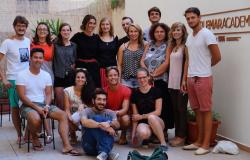 The cell in which a monk turned on his torturer during the Inquisition and killed him is opening to the public this weekend as part of renovation work on former jail cells in the Sicilian city of Palermo.
The cell in which a monk turned on his torturer during the Inquisition and killed him is opening to the public this weekend as part of renovation work on former jail cells in the Sicilian city of Palermo.
Graffiti by prisoners held in the Steri complex, once the Inquisition's Palermo headquarters, has attracted the attention of historians for some years. But there has been a flurry of fresh excitement in recent weeks, with news that experts have discovered the cell in which the legendary Diego La Matina committed murder.
From 1601 till 1782, the Inquisition tortured, tried and killed countless prisoners in the Steri prison yet only La Matina turned the tables on his captors.
The story of the tortured monk, immortalized by the Italian writer Leonardo Sciascia in one of his novels, tells that La Matina was charged with heresy and bound with chains.
While being tortured, however, he snapped, and turned on the famous inquisitor Don Juan Lopez De Cisneros, striking him with his chains and killing him.
The well-known story has now received corroboration through the discovery of a document in the Inquisition archive in Madrid.
"The document, which was originally sent from Palermo to Madrid to report the killing of the inquisitor, has helped us identify the precise room where the murder took place," explained the head of the restoration team, Domenico Policarpi.
"We have also discovered the stairs that linked the area to the main Steri building, which the inquisitor's secretary used to escape and sound the alarm".
The identification of the cell is the latest in a series of spectacular discoveries made by the team working on the complex.
Sections of the graffiti were first discovered in the early 1900s by the historian Giuseppe Pitre, who rescued them from destruction, but it is only in recent years that experts have started methodically uncovering the walls in search of past lives.
While prison graffiti is not uncommon, the Palermo complex is considered unique. This is because inscriptions left by inmates are usually anonymous but many of those held in the Palermo cells left invaluable details that are helping experts reconstruct their lives, including names and dates.
Among those identified so far are Francesco Mannarino, who was held in the prison in 1610, and Paolo Majorana, who was there in 1681.
Another fascinating detail is the artwork completed by the inmates.
Workers have painstakingly scraped off centuries of plaster to reveal massive paintings covering entire walls, coloured with dung, excrement, fragments of terracotta and possibly egg yolks.
Images of Christ and the various saints, vie for space with prayers, imprecations, personal stories and the memories of those incarcerated there.
Anyone imprisoned in the jail was unlikely to emerge alive, as the Inquisition was notoriously ruthless with suspected heretics, soothsayers and blasphemers.
"However, many of the victims were simply intellectuals or artists whom the Church considered a threat to its power," explained Policarpi.
The discoveries by the team working on the site are particularly valuable to historians, as Viceroy Domenico Caracciolo ordered all the Inquisition's documents burned in 1782.
Work to convert the complex into a museum began in 2004 and should be completed next year.
The museum, which will eventually include a library, auditorium and documentation centre, will be unique, as these are the only surviving testimonies of Inquisition victims anywhere in the world.
Meanwhile, visitors to Palermo can get a foretaste of the cells' grim treasures when they temporarily open to the public in October as part of the city's Via dei Tesori initiative. Sections of the complex will be open for four weekends in October, from 10am until 6pm. Entry is free.











